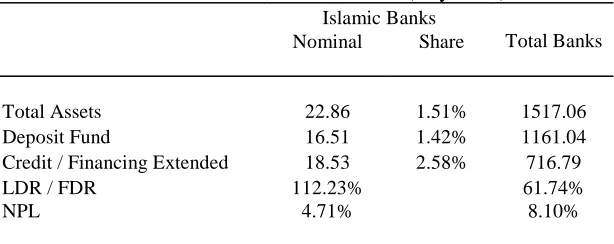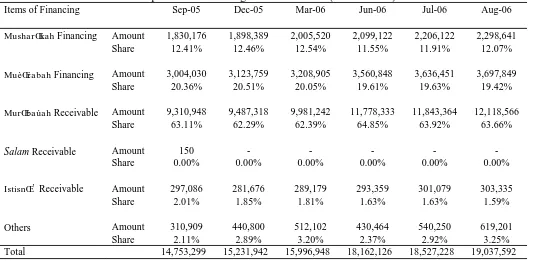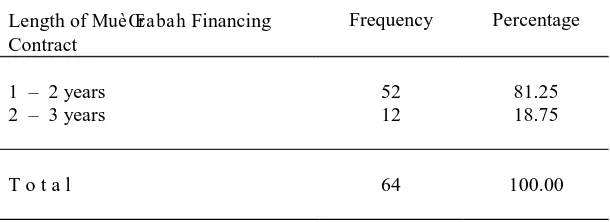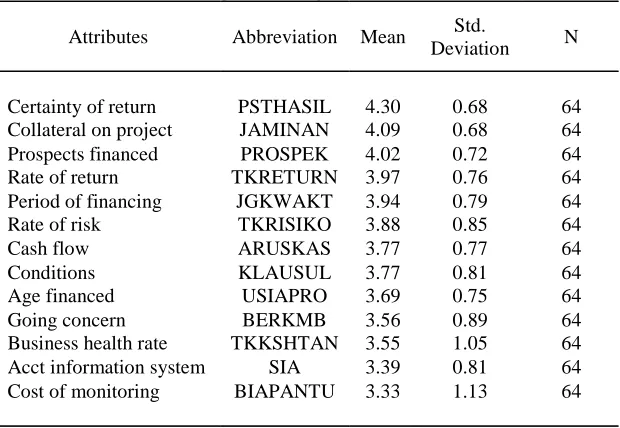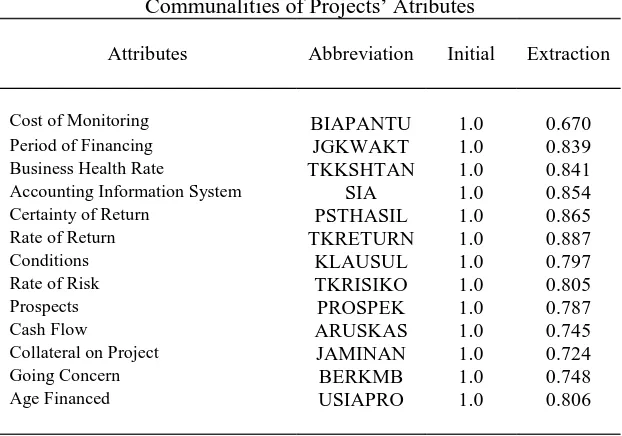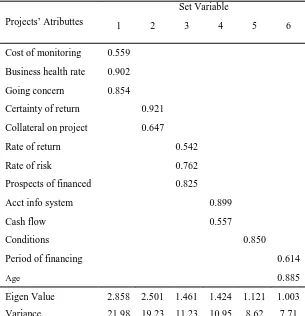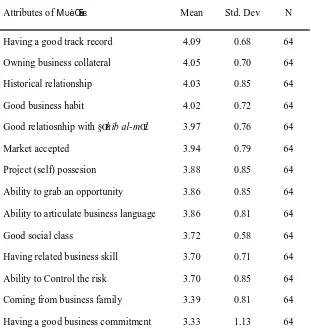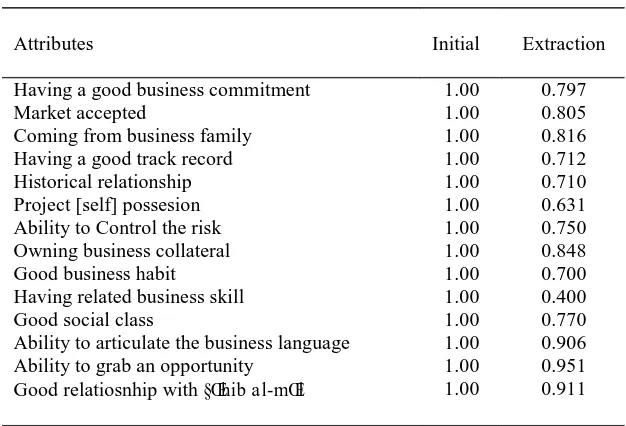ABSTRACT
This study examines the agency problems that arise in M Um RA BA Hfinancing in Indonesian Rural Sharia Banks. The study focus on project attributes, especially those projects that might consider M Um RA BA H financing, and the attributes of M Um RI B who received financing. The research is explorative in nature, combining both qualitative and quantitative approaches. The study found that six attributes were considered relevent from the M Um RA BA H projects point of view. These include: the prospect of the project, availability of collateral, healthiness of the project, the project’s financial statements, clarity of contract conditions, and conformity of time period. With regard to M Um RI B attributes, five characteristics were considered important. They include: business capacity, collateral, M Um RI B’S reputation and family background, and their business commitments. Further quantitative analysis has also been conducted to examine those attributes.
JEL classification: Z12, G10, D82
Keywords: Islamic economics, Islamic finance, Asymmetric information. AGENCY PROBLEMS IN MUë •RABAH
FINANCING: THE CASE OF SHARIA (RURAL) BANKS, INDONESIA
Muhammad Akhyar Adnanaand Muhamadb
aAssociate Professor, Department of Accounting, International Islamic
University Malaysia, P.O. Box 10, 50728 Kuala Lumpur, Malaysia (email: akhyar@iiu.edu.my).
bSTIE Yogyakarta, Jl. Abu Bakar Ali 3A, Yogyakarta, Indonesia (email:
aisar_ma@telkom.net).
1. INTRODUCTION
The formation of Sharia banks in Indonesia started in 1991 (Islamic or Shar¥cah banks are referred to as Sharia banks by the Central Bank of Indonesia).Bank Mualamat Indonesia (BMI) became the first Islamic bank in 1992, after the Indonesian Parliament passed the Banking Act No. 7, 1992 (following the promulgation of Government Regulation No. 72, 1992). The growth of the industry became more progressive after the Banking Act No. 7 was amended by the Banking Act No.10, 1998. According to Banking Act No.10, 1998, the Indonesian banking industry is classified into two levels: the General or Sharia banks and the Rural
Sharia banks. Bank Indonesia (Central Bank of Indonesia) statistics
show that in July 2006 there were three full fledged Sharia banks, 10
Sharia banking units1 and 94 Rural Sharia banks. These do not include
more than 3000 Bayt al-MŒl wa al-Tamw¥l (BMT), or micro-finance industry establishments, that were operating under the Cooperative Act (BMT’s legally function like Sharia banks, however they cannot be classified as such).
Currently, the market share of the industry is small, however, growth has been remarkable. Table 1 tabulates market share development in comparison to the banking industry as a whole in July 2006. Forecasts of the industry’s future have also been bright. For example, Karim Business Consulting (KBC) forecasted that the Islamic bank market share could potentially reach 6.67 percent of the banking industry by
TABLE 1
Islamic Banks’ Share in Indonesia (July 2006)
Islamic Banks
Nominal Share Total Banks
Total Assets 22.86 1.51% 1517.06
Deposit Fund 16.51 1.42% 1161.04
Credit / Financing Extended 18.53 2.58% 716.79
LDR / FDR 112.23% 61.74%
NPL 4.71% 8.10%
Notes: LDR: Loan (credit) extended to deposit ratio. FDR: Financing extended to deposit ratio.
2008. Alternately, the Central Bank of Republic Indonesia predicted the share to be 5.18 percent. Despite good growth and increasing market share, the overall contribution of Islamic banks in Indonesia is still below industry expectations. These expectations are based, inter alia, on the fact that Indonesia is a country with the biggest Muslim population. With a total population of over 238 million, and over 80 percent are Muslim. Therefore, market share of the Islamic banking sector should ideally be greater than what has been achieved to date.
The contribution of Islamic banks in Indonesia towards national economic growth remains dependent to a large extent on how they are able to operate effectively, either in offering attractive products or services, or in playing a constructive social-mediation role. As elsewhere, this is a balance between the availability of surplus funds (capital), and the need for investment funds (various capital requirements). Most Sharia banks in Indonesia have offered the following products:
(1) Funding products which include: (a) Wad¥cah Current Account (b) MuèŒrabah Saving Account (c) MuèŒrabah Investment Account
(2) Financing products, including: (a) Mur Œba úa h
(b) Bayc al-Salam (c) Bayc al-Isti§nŒ’ (d) IjŒrah
(e) Muè Œra ba h (f) MushŒra ka h
(3) Supporting products which cover: (a) Al-Wa kŒla h
(b) Al-KafŒlah (c) Al-HiwŒlah (d) Al-Qa rè a l-úa sa n
IIUM Journal of Economics & Management
15, no. 2 (2007)
TABLE 2
Composition of Financing for Islamic Banks (Million IDRs)
Items of Financing Sep-05 Dec-05 Mar-06 Jun-06 Jul-06 Aug-06
Amount 1,830,176 1,898,389 2,005,520 2,099,122 2,206,122 2,298,641
MusharŒkah Financing
Share 12.41% 12.46% 12.54% 11.55% 11.91% 12.07%
Amount 3,004,030 3,123,759 3,208,905 3,560,848 3,636,451 3,697,849
MuèŒrabah Financing
Share 20.36% 20.51% 20.05% 19.61% 19.63% 19.42%
Amount 9,310,948 9,487,318 9,981,242 11,778,333 11,843,364 12,118,566
MurŒbaúah Receivable
Share 63.11% 62.29% 62.39% 64.85% 63.92% 63.66%
Amount 150 - - - - -
Salam Receivable
Share 0.00% 0.00% 0.00% 0.00% 0.00% 0.00%
Amount 297,086 281,676 289,179 293,359 301,079 303,335
IstisnŒ’ Receivable
Share 2.01% 1.85% 1.81% 1.63% 1.63% 1.59%
Amount 310,909 440,800 512,102 430,464 540,250 619,201
Others
Share 2.11% 2.89% 3.20% 2.37% 2.92% 3.25%
their operations on products such as muè Œra ba h and musha rŒka h since these two products are closer to the equity-based economy. However, the latest developments in Islamic banking does not exactly show this trend (Karim, 2001; Warde, 1999). Mujiyanto (2004) reported that in Indonesia, muèŒrabahcontributes only 14.33 percent, while musharŒkah even less at 2.86 percent, of total Islamic financing.
Table 2 tabulates the current development of financing modes in Indonesia. While it shows a promising change, the total composition of product portfolio has yet to yield the outcomes as expected by Ahmad (2000) and Adnan (2003). The figures presented indicate the significant differences between theory, expectations and reality. It is undeniable that a number of factors are in play. Two different perspectives can therefore be applied. One is internal Islamic banking factors and the other is external factors. A full understanding of the products offered, like muèŒrabah, is one such important internal factor. The readiness to deal with risk is another. Most Islamic bank managers are accustomed to the risk-averse, rather than the risk-taking approach. This implies that muèŒrabah has been perceived as a risky product. The risk is in fact related to agency issues associated with external factors, where the honesty, transparency and trustworthiness of the consumers cannot be guaranteed.
THE muèŒrabahcontract is an agreement between two or more parties, where profit and loss are shared between the capital owner or the principal, and the agent or bank’s consumer. It is important therefore to understand that the contract functions effectively when both parties are ready and willing to be transparent. This includes disclosure of all aspects of the businesses they have agreed upon. Such a contract is strongly associated with moral hazard particularly in the context of asymmetric information that is likely to be unavoidable in the contract of muè Œra ba h.
2. RESEARCH QUESTIONS, OBJECTIVES AND CONTRIBUTION
1. What are the attributes of the projects that are considered by the§Œhib al-mŒl(Islamic banks) in financing muèŒrabah projects.
2. What are the attributes of the muèŒrib that are considered by the §Œhib al-mŒlin financing muèŒrabah projects?
In the second level, the study aims at examining the model designed to ensure that those attributes (from the first level questions) can effectively reduce agency problems. The questions raised are as follows:
1. How far can the screening mechanisms of project attributes reduce agency problems in muèŒrabah financing?
2. How far can the screening mechanisms of muèŒrabah projects reduce agency problems in muèŒrabah financing?
There is a demonstrable need to orientate the Islamic banking industry to be closer to the real rather than the financial sector (Adnan, 2003) or from debt-based to equity-based financing (Ahmad, 2000), i.e. those that promote muèŒrabah and musharŒkah. However, industry data, particularly in Indonesia, and at the international level, indicate the contrary. Obstacles remain when muè Œra ba h products are being offered, such as moral hazard, asymmetric information and so forth. Significantly, there has been no research conducted to specifically investigate these attributes, especially in the Indonesian context.
This study is an effort to offer a solution to these problems. It is expected that the attributes investigated will contribute to the general knowledge about muè Œra ba h practices. Furthermore, the Islamic banking industry is likely to benefit from utilizing these attributes in order to promote one of the basic tenets of Islamic economics.
3. BACKGROUND
Khalil, Rickwood and Muride (2000) conducted research related to the characteristics of agency problems in muèŒrabah contracts
between Islamic banks and their customers. They found the following problems: (1) risk problems caused by moral hazard and adverse selection (2) linear relationships between projects and profit, and (3) discretionary power. They also identified several aspects which were considered important by the §Œhib al-mŒl in their selection: (1) the muèŒrib or projects (2) the criteria to accept or reject (3) the factors that determine the profitability of projects (4) the variables that can be used to restructure the muèŒrabah contract (5) agency problems and (6) monitoring and contractual governance. However, the study did not identify the influence or the contribution of the factors found in agency problems faced in muèŒrabah.
Karim (2000), in studying the suitability of muè Œra ba h and
mushŒrakah, financing found that muè Œr a ba h and musha r Œka h
financing fit small and medium business enterprises, provided that incentive compatible constraint mechanisms are applied. These include: (1) the setting up of capital proportion or the collateral contributed by the muèŒrib (2) a minimum operational business risk (3) the project should be ready with financial statements, and (4) the project has relatively low uncontrollable expense.
According to Sumiyanto (2004) who conducted research on muèŒrabah at BMT found that project attributes, muèŒrib compliance and financing prerequisites, have a significant role in the increasing muè Œr a ba h contract between the BMTs and their customers. However, this study was more focused on BMTs instead of Islamic banks, which are much bigger in terms of size and complexity.
In addition to the studies above, Darmawangsa (2003) implemented the case study approach and found that gharŒr will emerge in
3.1 LITERATURE REVIEW
This study is conducted because of the low proportion of muèŒrabah financing offered by Sharia banks in comparison to other products such as murŒbaúah or other ‘trading’ products. Indeed, this is why many critics have raised questions about the operations of Sharia banks (see for example Kuran, 1986; Weiss, 1999; Ahmad, 2000; Adnan, 2003). Among the concerns of the muèŒrabah operation is the possibility of agency problems linked with modern investments. Jensen and Meckling (1976) are among the pioneers who raised the issue of agency problems. The agency concept is related to incentive based contracts, where the rewards are provided by the principal for the party working to improve productivity (Pass, Lowes and Davies, 1985). The reward can be in the form of a bonus, profit-related-pay or profit sharing.
A muèŒrabah contract is defined as a contract between the §Œhib al-mŒl (in this case the capital provider) and the muèŒrib (business operator) in which the profit earned is shared according to a previously agreed upon proportion. This includes the case of loss, which the two parties will also share, the capital provider being responsible for financial loss and the muèŒrib being charged with non-financial loss (see for example Antonio, 2000). The modern investment concept is not exactly similar to the muèŒrabah concept, despite some similarities. Therefore, it is possible to associate muèŒrabah with the agency problem.
Jensen and Meckling (1976) offered two methods by which a capital owner can reduce the risk of an inappropriate conduct of an agent. One is by monitoring the agent, and the second is by bonding the manager or agent to certain positive outcomes. Consequently, this process limits the opportunity for an agent to mismanage or abuse the project, which at the same time increases expenses and reduces profit. Any residual losses are categorized as an agency cost. According to Rechelstein (1992), the agency problem will arise when the principal hires the agent, and the agent does not share what he or she has earned. Stiglitz (1992) views that the agency problem exists if in the relationship between the principal and the agent there is imperfect or asymmetric information.
model under default probability. He further stated that the existence of asymmetric information might influence the return to investment.
The principal-agent relationship in the muèŒrabah context has been discussed theoretically by Ahmad (2000). Ahmad analyzed the limited information obtained by the principal on the muè Œrib, where he proposed for the adverse selection index. Ahmad also suggested that the difference should be identified through auditing practices. An example of moral hazard might be excessive project cost (window dressing) and retaining some of the profit earned.
In addition, there is also a need to screen both the projects and the muèŒrib. The screening, may help the §Œhib al-mŒl reduce related problems. Some variables were identified and proposed. In terms of the project, they are: profitability, return, risk, monitoring cost, accounting aspects, related social and environmental support, contract period, cash flow and collateral (Khalil, Rickwood and Murinde, 2000). In terms of the muèŒrib, they are: reputation, experience and qualification, religiosity, and the ability to access information (Khalil, Rickwood and Murinde, 2000). In addition, Sumiyanto (2004) added: track record, business skill base, ability to adjust to business risk and ownership of the business.
4. RESEARCH METHOD
The study applies the “combined qualitative and quantitative design” method (Cresswell, 1994). This method is used because the area under study is still in its infancy and is still trying to seek possible factors related to the issue of agency problems in muèŒrabah practices. While, the qualitative approach is an appropriate method to be applied, there is a strong willingness to examine those potential factors quantitatively as well. According to Niglas (2004), this approach can be a complement between the qualitative and quantitative approaches. As he adds: “there is a possibility to use both quantitative and qualitative data within each study regardless of the overall strategy of a piece of research or the concrete data-gathering techniques.” According to Cresswell (1994), combined research can be considered in one of following research designs: (1) the two-phase design, (2) the dominant-less dominant design, or (3) the mixed-methodology design. Based on this classification, this research might be classified as a two-phase design.
statistically. In the qualitative step, the explorative approach is applied. This includes the following procedures (1) key-informant technique; (2) focus group interview; (3) secondary-data analysis, and (4) case study method (Mudrajad, 2003). The attributes identified, either with regard to projects or muèŒrib, are then examined quantitatively.
The samples are the Bank Perkreditan Rakyat Syariah2 (BPRS or Sharia Rural Banks) managers. It represents the banks in two important islands of Indonesia, namely Sumatra and Java (which includes West, Central and East Java). The BPRS were chosen on the basis of purpose cluster sampling method. The samples selected were required to conform to the following conditions: first, the bank had been applying the muèŒrabah contract, and second, the muèŒrabah contracts had been operating for a period of at least three years before the commencement of the study. There were 89 BPRS or Sharia Rural Banks in Indonesia during the time of the study. 84 were sent questionaires, 64 of them either replying or deemed eligible for analysis. Finally, 16 of the 64 BPRS managers were selected to be interviewed. Primary data was collected by interview and by the observation approach. The qualitative data was then examined by using the triangulation technique (Moleong, 2000). It is important to ensure that the data was valid and reliable. In turn, this guarantees that the knowledge generated is true, researchable, verifiable and can be generalized (Strauss and Corbin, 2003). On the other side, the validity and reliability of examination of the quantitative part is conducted with product moment correlation and alpha techniques. Research variables were decided after exploratory steps were conducted. As alluded earlier, the following items were investigated during the research. First, the possible attributes associated with the projects, which include the characteristic of projects deemed by the bank to be worthy of finance. Second, possible attributes related to muèŒrib, which comprise the characteristics of muèŒrib considered by the bank before contracts were approved and finally, agency problems in the muèŒrabah contract. Agency problems deal with the disobedience of muèŒrib v’s-a-v’s the agreed contract, particularly in terms of profits earned that must be shared with the bank. The agency problem was measured by comparing the percentage of expected and actual return (Ahmad, 2000).
considered by the Islamic banks’ management in deciding both projects as well as muèŒribs prior to the approval of the muèŒrabah contract. The quantitative analysis was designed to examine the investigated attributes identified in the qualitative approach. Two more techniques were also applied at this level. First, factor analysis screened attributes of projects and muè Œribs statistically. This was then followed by regression analysis. This ensures to what extent the screened attributes are involved in agency problems. This approach strongly suggests that this research may constitute a new model.
5. DATA ANALYSIS AND RESEARCH FINDINGS
The analysis follows these steps: (1) description of how muèŒrabah is practiced in the BPRS; (2) exploratory analyses of project and muèŒribs’ attributes; (3) analyses of factors attributed to projects as
well as muèŒribs in financing muèŒrabah contracts; (4) research model confirmation.
5.1 DESCRIPTION OF MUë •RABAH PRACTICES
Table 3 describes the portion of muèŒrabah contracts included in the samples. The figures are in line with the data issued by the Central Bank of Indonesia, where muè Œra ba h contracts constituted 15.35 percent in 2004 (and 19.42 percent in August 2006) of the total financing products applied.
The muèŒrabah contract can be further classified into two types.
between 2 to 3 years. None were longer than 3 years. The trend indicates that the BPRS were avoiding longer contracts due to limited funds available for financing, since the BPRS are classified as small to medium size banks, and that the banks followed ‘urf or “socio-cultural habit” or business practices in general. As indicated in Table 6, the trading sector dominated the muèŒrabahcontract, accounting for 51.56 percent of total share. According to the bank managers interviewed, trading is the most manageable sector. This is consistent with conditions
TABLE 3
The Proportion of MuèŒrabah financing at BPR Sharia in 2004
The proportion of MuèŒrabah financing of the total financing products offered
Frequency Percentage
Less than 5% 5% - 10% 10% - 15% 15% - 20 % More than 20%
24 0 0 40
0
37.50 0 0 62.50
0
T o t a l 64 100.00
TABLE 4
The Proportion of MuèŒrabah Mu‹laqah and MuèŒrabah
Muqayyadah at BPR Sharia in 2004
Types of MuèŒrabah Frequency Percentage
MuèŒrabah Mu‹laqah MuèŒrabah Muqayyadah
36 28
56.25 43.75
such as the availability of financial statements and other related documents. In turn, this facilitates the banks in undertaking their control function. Moreover, the trading sector is more flexible than for instance, agriculture and husbandary, which are subject to external factors such as weather, seasons and so forth.
5.2 EXPLORATORY ANALYSIS
With respect to the exploratory analysis of attributes of projects and muèŒrib based on questionaires circulated and the in-depth interview,
TABLE 5
Length of MuèŒrabah Financing Contract in BPR Sharia in 2004
Length of MuèŒrabah Financing Contract
Frequency Percentage
1 – 2 years 2 – 3 years
52 12
81.25 18.75
T o t a l 64 100.00
TABLE 6
Types of Business / Industry Financed under MuèŒrabah by BPR
Sharia in 2004
Types of Business / Industry Frequency Percentage
Agriculture Animal husbandary Trading
Manufacturing Craft
Other
7 15 33 9 0 0
10.94 23.44 51.56 14.06
0 0
the following projects attributes are noted in choosing muèŒrabah projects: minimum business risk; accounting information system; the certainty of return; low monitoring cost; the project’s rate of return; project soundness; guarantee or collateral; project cash flow; contract period; project horizon; project’s prospect; business’s going concern; contract condition.
Based on the same method for exploring project attributes, the following factors are considered important by the management of BPRS, with regard to muèŒrib’s attributes. They are: having skill in the related business or area; market familiarity; ability to correct business risk; possesing collateral; family business background; business commitment; ability to articulate particular business language; having business habit; having own business; historical business lingkage with §Œhib al-mŒl; ability to grasp business opportunity; social class; ability to anticipate business risk; and track record.
5.3 ANALYSES OF FACTORS
There are several attributes noted for both the projects and themuèŒrib from the BPRS management point of view. In this section those attributes are statistically examined. Table 7 shows the ranks of the attributes
TABLE 7
Ranking of all Projects’ Attributes
Attributes Abbreviation Mean Std.
Deviation N
Certainty of return PSTHASIL 4.30 0.68 64
Collateral on project JAMINAN 4.09 0.68 64
Prospects financed PROSPEK 4.02 0.72 64
Rate of return TKRETURN 3.97 0.76 64
Period of financing JGKWAKT 3.94 0.79 64
Rate of risk TKRISIKO 3.88 0.85 64
Cash flow ARUSKAS 3.77 0.77 64
Conditions KLAUSUL 3.77 0.81 64
Age financed USIAPRO 3.69 0.75 64
Going concern BERKMB 3.56 0.89 64
Business health rate TKKSHTAN 3.55 1.05 64
Acct information system SIA 3.39 0.81 64
TABLE 9
Communalities of Projects’ Atributes
Attributes Abbreviation Initial Extraction
Cost of Monitoring BIAPANTU 1.0 0.670 Period of Financing JGKWAKT 1.0 0.839 Business Health Rate TKKSHTAN 1.0 0.841 Accounting Information System SIA 1.0 0.854 Certainty of Return PSTHASIL 1.0 0.865 Rate of Return TKRETURN 1.0 0.887 Conditions KLAUSUL 1.0 0.797 Rate of Risk TKRISIKO 1.0 0.805 Prospects PROSPEK 1.0 0.787 Cash Flow ARUSKAS 1.0 0.745 Collateral on Project JAMINAN 1.0 0.724 Going Concern BERKMB 1.0 0.748 Age Financed USIAPRO 1.0 0.806
and their standard deviations. The standard deviations indicate to what extent the §Œhib al-mŒl rank the project attributes. The certainty of return is considered to be the most important attribute. The examination by the Kaiser-Meyer-Oklin (MKO) and Barlett measures of sampling of attributes confirm the result, as shown in Table 8. The coefficient for the Kaiser-Meyer-Olkin measure of sampling adequacy (MSA) was 0.502. This indicates that the samples used are sufficient, since the mark required by Hair et al. (1998) is 0.50. The interrelation of attributes can be seen from the coefficient of Bartlett’s Test of Sphericity, which is 297.63.
The analysis to determine the projects attributes is initiated by communalities analysis, which is tabulated in Table 9. This analysis
TABLE 8
Summary of Kaiser-Meyer-Olkin (KMO) and Bartlett Examination Kaiser-Meyer-Olkin Measure
Bartlett's Test
0.502
grouped attributes which have a significant relationship. They were analysed using the orthogonal varimax method. The summary of results are tabulated in Table 10. There are six factors out of 13 which contributed 79.75 percent to the total projects attributes, each with the following figures: component 1 = 21.98 percent, component 2 = 19.24 percent, component 3 = 11.24 percent, component 4 = 10.95 percent, component 5 = 8.63 percent and component 6 = 7.72 percent. The result of principal component analysis with extraction method and varimax rotated component explains the content of each component.
The first component is named Project Soundness which includes project monitoring cost with coefficient value of 0.559, business health
TABLE 10
Projects Attributes Based on Factor Analysis
Set Variable
Projects’ Atributtes 1 2 3 4 5 6
Cost of monitoring 0.559
Business health rate 0.902
Going concern 0.854
Certainty of return 0.921
Collateral on project 0.647
Rate of return 0.542
Rate of risk 0.762
Prospects of financed 0.825
Acct info system 0.899
Cash flow 0.557
Conditions 0.850
Period of financing 0.614
Age 0.885
Eigen Value 2.858 2.501 1.461 1.424 1.121 1.003
Variance 21.98 19.23 11.23 10.95 8.62 7.71
TABLE 11
Ranking of All Attributes of MUèŒRIB
Attributes of MUèŒRIB Mean Std. Dev N
Having a good track record 4.09 0.68 64
Owning business collateral 4.05 0.70 64
Historical relationship 4.03 0.85 64
Good business habit 4.02 0.72 64
Good relatiosnhip with §Œhib al-mŒl 3.97 0.76 64
Market accepted 3.94 0.79 64
Project (self) possesion 3.88 0.85 64
Ability to grab an opportunity 3.86 0.85 64
Ability to articulate business language 3.86 0.81 64
Good social class 3.72 0.58 64
Having related business skill 3.70 0.71 64
Ability to Control the risk 3.70 0.85 64
Coming from business family 3.39 0.81 64
Having a good business commitment 3.33 1.13 64
TABLE 12
Kaiser-Meyer-Olkin (KMO) and Bartlett Test
Kaiser-Meyer-Olkin Measure
Bartlett's Test
0.573
rate with coefficient of 0.902 and business’s going concern with coefficient of 0.854. The second component is named Repayment Guarantee which include payment certainty and project collateral, with coefficients of 0.921 and 0.647 respectively. The third component consists of the project’s rate of return (0.542), project risk (0.762), and prospect of the project (0.825). This component is identified as Project’s Prospect.The fourth component is classified as Financial Aspect, which include accounting information system (0.899) and the project’s cash flow (0.557). The fifth component is identified as Contract Conditions, which include the conditions required by the contract (0.850) and finally the project age (0.885). All attributes mentioned above have loading factor greater than 0.05.
Hence, it can be concluded that what have been considered by Islamic banks in financing the projects are: the project soundness, the repayment guarantee, the prospect of the project, financial aspects (financial statements), project conditions and project age.
With regards to muèŒrib’s attributes, as stated earlier, there are 13. Table 11 dislcoses the level of importance of attributes considered by the bank with respect to the muèŒrib. The business track record has been ranked first, followed by collateral, and so forth. The sample suitability test was also undertaken for this case, where the Kaiser-Meyer-Olin and Barlett examination was applied. The result is as shown in Table 12. The Kaiser-Meyer-Olkin measure of sampling adequacy (MSA) is 0.573. This indicates that the samples used are sufficient. The intervariable correlation can be referred to by the coefficient of Bartlett’s test of sphericity, that is 496.605. Further analysis is required to determine the attributes by communalities analysis. The result is tabulated in Table 13.
TABLE 13
Communalities Attributes of MuèŒrib
Attributes Initial Extraction
Having a good business commitment 1.00 0.797
Market accepted 1.00 0.805
Coming from business family 1.00 0.816
Having a good track record 1.00 0.712
Historical relationship 1.00 0.710
Project [self] possesion 1.00 0.631
Ability to Control the risk 1.00 0.750
Owning business collateral 1.00 0.848
Good business habit 1.00 0.700
Having related business skill 1.00 0.400
Good social class 1.00 0.770
Ability to articulate the business language 1.00 0.906
Ability to grab an opportunity 1.00 0.951
Good relatiosnhip with §Œhib al-mŒl 1.00 0.911
al-mŒl. The third component includes the following attributes: market accepted; having a good track record; and having related business skills. They are named as ‘Reputation.’ The fourth component consists of: coming from a business family, project (self) possesion, and good social class. They are identified as ‘Background.’ The last component is known as Business Commitment and constitutes of the following attributes: having a good business commitment and historical relationship. All those attributes have a loading factor of more than 0.05.
5.4 REGRESSION
TABLE 14
Variable Names and MuèŒribs Attributes based on Factor Analysis
SET VARIABLE
Attributes of MuèŒrib 1 2 3 4 5
Ability to control the risk 0.777
Ability to articulate the business language
0.925
Ability to grab an opportunity 0.968
Owning business collateral 0.877
Good business habit 0.644
Good relatiosnhip with §Œhib al-mŒl
0.947
Market accepted 0.859
Having a good track record 0.975
Having related business skill 0.514
Coming from business family 0.583
Project [self] possesion 0.528
Good social class 0.826
Having a good business commitment
0.782
Historical relationship 0.625
Eigen Value 3.706 2.384 2.125 1.319 1.173
Variance 26.47 17.03 15.18 9.42 8.38
variables are examined with regession analysis, the following result is obtained (t-statistics in parenthesis):
AGPROB = 0.434 + 0.0614 KSHTPROY + 0.125 PROSPROY (4.05) (2.30) (2.36)
+ 0.234 LAPKEU+ 0.574 PERSYKLA + 0.274 WKTKONTR (2.37) (4.46) (2.61)
The F statistic is 10.784, which indicates that the variables significantly affect the agency problem in the muèŒrabah contract. Furthermore, the adjusted R2 is 0.437 which means 43.7 percent of the variance of the agency problem is explained by the model.
The coefficient for project soundness is 0.06 and significant. This indeed is low, but it has a significant effect toward minimizing agency problems among the BPRS. The coefficient for the other variables are positive (project’s prospect, financial reports, contract condititions and length of contract). Therefore, it can be concluded that those attributes can be screened to reduce agency problems in the muèŒrabah contract. The same method is applied to the attributes of the muèŒrib. There are five main attributes identified: (1) business skill (KEMBIS) (2) collateral (JAMINAN); (3) reputation (REPUTASI) (4) background (ASALUSUL); and (5) business commitment (KOMITMEN). The regression analysis resulted in the following coefficients regression (t-statistic in parenthesis):
AGPROB = 0.526 + 0.103KEMBIS + 0.144 JAMINAN (5.78) (3.72) (3.05)
+ 0.165 REPUTASI+ 0.148 ASALUSUL + 0.220 KOMITMEN (3.73) (2.44) (2.02)
The F statistic is 13.581, indicating that the variables are effective in preventing agency problems in the muèŒrabah contract at Islamic banks or BPRS. The adjusted R2 is 0.50, which means that 50 percent of agency problems are explained by the model.
As discussed above, the research found six attributes of projects and 5 attributes of the muèŒrib. A combination of them (11 attributes) are once again tested by regression analysis. The result shows that the
F statistic is 13.609 with an adjusted R2 of 0.69. Therefore it can be
concluded that all of the variables combined explained 68.8 percent of the possible agency problems that arise in the muèŒrabah contract.
However, a further assestment of individual variables resulted in only 5 variables having significant influence. They are: (1) business skill of the muèŒrib, (2) business reputation of the muè Œrib, (3) business commitmnent of the muèŒrib (4) financial report of the project, and
(5) the length of contract for the project. Based on the above findings, the model proposed is (t-statistic in parenthesis):
AGPROB = 0.409 + 0.150 KEMBIS + 0.142 REPUTASI (4.10) (2.08) (2.75)
+ 0.349 KOMITMENT + 0.540 LAPKEU + 0.343 WAKTKONT (3.22) (3.21) (3.40)
6. CONCLUSION
The study investigated how muèŒrabah financing has been practiced by the BPRS. From a descriptive-statistics point of view, the study found the following. First, 62.5 percent of respondents offer between 15–20 percent of muèŒrabah financing to customers, and the rest (32.5 percent) offer less than 5 percent. Second, 56.25 per cent of respondents prefer muè Œra ba h mu‹la qa h, instead of muè Œra ba h muqa yya da h. Third, 81.25 per cent of banks signed the muèŒrabah contract between 1–2 years, and 51.56 percent of banks had muèŒrabah with the trading industry.
The study then identified qualitatively the attributes of both projects and muèŒribS which are perceived by the §Œhib al-mŒl. The research
initially found thirteen attributes related to the project and 14 attributes related to the muèŒrib. However, after further screening, it was found that 5 main attributes related to the project and 6 attributes related to the muè Œrib.
The five attributes stated above can be seriously considered by the Islamic bank management to determine both the project and muèŒrib before the contract is signed. As proven by analysis, the selected attributes are identified as the factors that might potentially reduce agency problems which is perceived as one of the reasons why the muèŒrabah contract is not widely practiced by Islamic banks.
Finally, some limitations cannot be avoided. First, the scope of the research was focused on BPRS, which represent ‘small’ Islamic banks in Indonesia. BPRS is a rural bank limited by size, capital and location. The second limitation is the number of samples. The sample size is statistically accepted, however it is undeniable that a larger sample, as well as broader scope might possibly, but not necessarly, produce a more accurate or representative result. The third is related to research methodology. As there are many possible statistical tools that can be applied, this research applied selected methods. This means that the aplication of other possible research methods might result in different findings. For this reason we humbly encourge other researchers to further examine what has been found by improving on some of these limitations.
REFERENCES
Adnan, M.A. “Perkembangan Gerakan Ekonomi Islam diIndonesia: Sebuah Evaluasi.” Paper presented in the 60th Anniversary Islamic
University of Indonesia, September 24, 2003.
Ahmad, K. “Islamic Finance and Banking: The Challenge and Prospect.”
Review of Islamic Economics 9 (2000): 57-82.
Antonio, M.S. Bank Syari’ah: Suatu Pengantar Umum. Edisi Khusus. Jakarta: Tazkia Institute, 2000.
Creswell, J.W., Research Design: Qualitative & Quantitative
Approaches. London: Sage Publications, 1994.
Darmawangsa. “Gharar Dalam Pembiayaan Mudharabah di BPRS Heurakat Aceh.” PhD diss., MSI-UII, 2003.
Harri, M. and A. Raviv, “Capital Structure and Informational Role of Debt,” Journal of Finance 45 (1990): 321-49.
Jensen, C.M. dan W.H. Mechkling. “Theory of the Firm: managerial Behavior, Agency Costs and Ownership Structure.” Journal of
Jensen, C.M. “Agency Cost of Free Cash Flow, Corporate Finance, and Takeover.” American Economic Review 76 (1986): 323-329. Karim, A.A. “Incentive Compatible Constrains for Islamic: Banking Some Leassons From Bank Muamalat.” Paper presented at the Fourth International Conference on Islamic Economics and Banking, Loughborough University, UK, August 13-15, 2000. Khalil, Abdel-Fattah A.A., C. Rickwood, dan V. Muride, “Agency
Contractual in Profit-Sharing Financing,” Islamic Finance:
Challenges and Opportunities in The Twenty-First Century,
Conference Papers, Fourth International Conference on Islamic Economic and Banking Loughborough University, UK, August 13-15, 2000.
Kuran, T. “The Economic System in Contemporary Islamic Thought: Interpretation and Assesment.” International Journal of Middle
East Studies 2 (1986): 135-164.
Moleong, L. J. Metodologi Penelitian Kualitatif, Bandung: PT. Remaja Rosdakarya, 2000.
Reichelstein, S. “Agency.” The New Palgrave Dictionary of Money
and Finance 2 (1992): 23-26.
Ross, S. “The Determination of Financial Structure: The Incentive Signalling Approach,” Bell Journal of Economics 8 (1977): 23-40.
Saeed, A. Islamic Banking and Interest, A Study of Prohibition of
Riba and Its Contemporary Interpretation, Leiden, New York,
Koln: EJ. Brill, 1999.
Stiglitz, E.J. “Principal and Agent,” The New Palgrave Dictionary of
Money and Finance 2 (1992): 185-190.
Strauss, A. and J. Corbin. Dasar-dasar Penelitian Kualitatif:
Tatalangkah dan Teknik Teoritisasi data, (translation by:
Muhammad Shodiq dan Imam Muttaqien), Yogyakarta: Pustaka Pelajar, 2003.
Sumianto, A. “Minat Manajer BMT di Yogyakarta dalam Menerapkan Produk Pembiayaan Mudharabah.” PhD diss., MSI-UII, 2004. Warde, I. “The Revitalization of Islamic Profit-and-loss Sharing,” In
Proceeding of the The Harvard University Forum on Islamic Finance. Cambridge: Harvard Islamic Finance Information
Program Centre for Middle Easter Studies, 1999.
Weiss, D. “The Struggle for a Viable Islamic Economy,” The Muslim
World 79 (1989): 46-58.
APPENDIX
The list of samples selected for in-depth interview
1. BPRS Harta Insan Karimah 2. BPRS Amanah Robbaniah 3. BPRS Syarif Hidayatullah 4. BPRS Al-Mabrur
5. BPRS Bangun Drajad Warga 6. BPRS Wakalumi
7. BPRS Bhakti Makmur Indah 8. BPRS Margirizki Bahagia 9. BPRS Amanah Sejahtera 10. BPRS Daya Arta Mentari 11. BPRS Artha Sinar Mentari 12. BPRS Ikhlasus Amal 13. BPRS Carana Kiat Andalas 14. BPRS Wadi’ah
